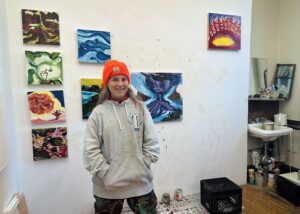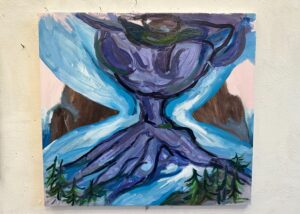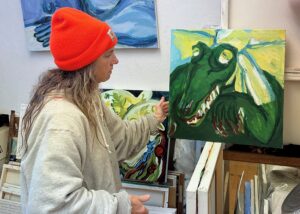In the center of a melancholy Norwegian landscape — with its brown mountain, cold sky, and rows of huddled evergreens — stands a massive chicken foot. It looks extraterrestrial, exploding from loose strokes in various shades of purple. It’s outlined in thick black and surrounded by rushing white and blue. The foot announces itself with a shout.

The artist, Jenny Humphreys, says this image was inspired by the landscapes of Norwegian painter Edvard Munch. She wanted to paint one for herself, but once it was finished, she felt that it was missing something.
“It needed something from outer space,” Humphreys says, pointing at the foot. “I don’t know the Norwegian landscape, but I know this feeling.”
This untitled painting is one of eight current works in progress that hang on the walls of Humphreys’s studio on the second floor of the U.S. Post Office in Provincetown. The studio, which she’s occupied since 2002, is chock-full of whimsical paintings: a black eye suspended beside a curled red flower, a yellow lake in a semicircle of red pines, a massive pink skeleton haunting the forest. The paintings vibrate with imagination.
Humphreys and her studio are prepared for a winter of work: water for tea boils on the mini stovetop, sweaters and bundles of fabric hug the windows to keep out the cold, and canvases, brushes, paint, and rags nestle in the sink. The focus that winter allows was what attracted Humphreys to Provincetown. After her first winter here, as a Fine Arts Work Center fellow in 1993, she was hooked, and she moved to town for good the following year. She now lives in North Truro. She’s spent her summers working a range of jobs, this season as a baker at Bagel Hound and the Flying Fish.

But winter has always been her time. “I’ve had members of my family say, ‘You have how much time off?’ ” she says. “And it’s like, ‘Yeah, I do. That’s when the work happens.’ ”
Humphreys grew up in Baltimore surrounded by art. Her father was a photographer, and her mother was a painter, but it wasn’t until that first Provincetown winter, she says, that “I felt comfortable telling people I was an artist as opposed to just saying, ‘This is something I’m trying to do.’ ”
Humphreys, who is represented by Four Eleven Gallery in Provincetown, received her master’s degree in painting at Indiana University in 1986 where she learned “the rules about what you can and can’t paint.” She says her journey as a painter has been learning to shed those conventions and to create at the whim of her own imagination. She approaches each canvas without a plan, doesn’t sketch beforehand, and allows whatever wants to come to come.
“If I want an eye in this painting today, I’m going to put the eye in it,” she says. “It makes me feel like I’m getting away with something. If you can’t do that with your art, where can you do that?”

The inspiration for a painting, Humphreys says, comes from an assortment of things: memories, nature, or even a single phrase she has stuck in her head. One such painting, Good Girl, depicts a crocodile with curled red fingernails and a yellow bow on its head. Humphreys says that before she began this piece she had become fascinated by saltwater crocodiles and had checked out a pile of books about them from the library. At the same time, the phrase “good girl” had been replaying in her mind for months.
“If you say ‘good girl’ to your dog, your cat, or whatever, they’re so happy,” she says. “During Covid, I kind of got in the habit of reminding myself ‘I’m a good girl.’ ”
When she approached the blank canvas, that phrase and saltwater crocodiles met in her mind and she painted without hesitation, her brush revealing that toothy-grinned reptile. Whether planned or not, the painting draws attention to the simultaneously empowering and infantilizing connotations of the phrase “good girl.” The dolled-up crocodile, Humphreys says, represents that “it’s OK to not be good all the time. If you’re good all the time, maybe you’re not being truthful to yourself, to your species.”

Humphreys says her goal is “to take what’s in my head and animate the canvas,” not to convey a singular narrative or meaning. In another of Humphreys’s paintings, Yellow Bear, colors and lines weave and curl together like yarn. A bear paw and face emerge reluctantly and then unmistakably between the confluences of color. Slowly, more life appears, the explosion of a small blue flower in the top right and then the slithering of a green snake and the sharp white slashes of ribs at the bottom left.
When asked if the snake and ribs were intentional, Humphreys laughs, “It’s fine with me.” She looks more closely at the canvas, as if seeing it for the first time. “Oh, yeah,” she says. “There are definitely some ribs there.”
Editor’s note: An earlier version of this article, published in print on Dec. 7, incorrectly reported the year of Jenny Humphreys’s graduation from Indiana University as 1988. It was 1986.



